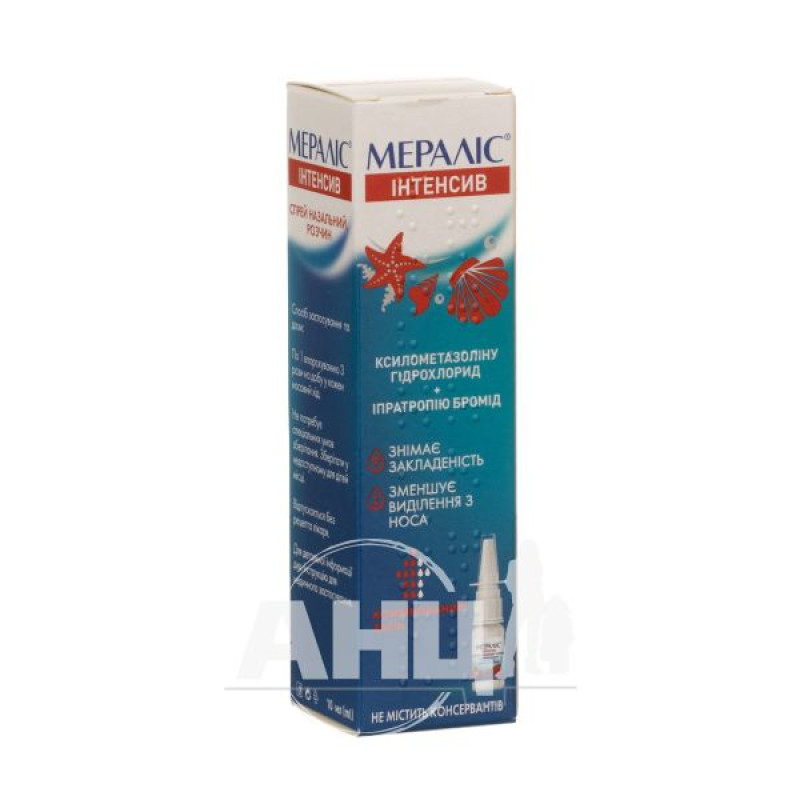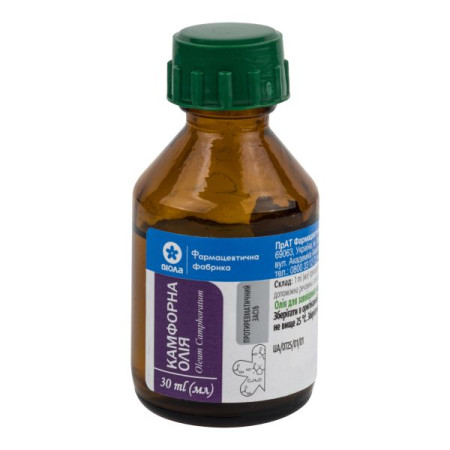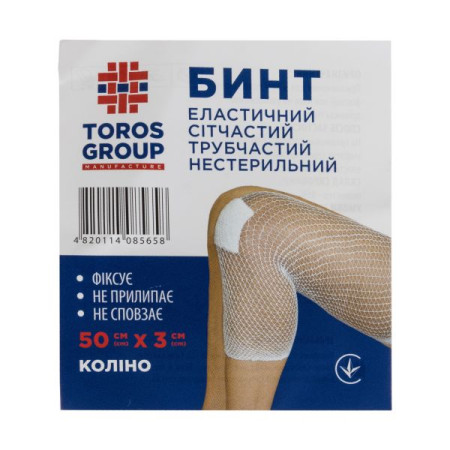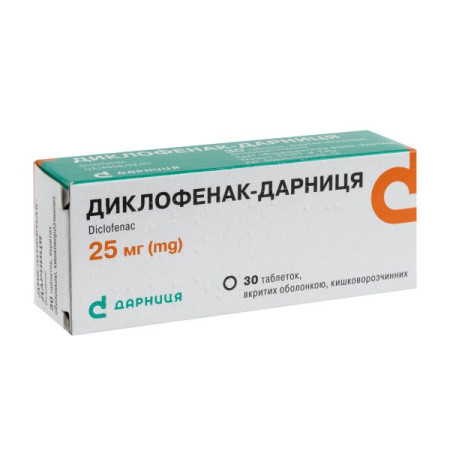Meralis Intensive spray nasal solution bottle 10 ml

Instructions for Meralis Intensive spray nasal solution bottle 10 ml
Composition
active ingredients: ipratropium bromide; xylometazoline hydrochloride;
1 ml contains ipratropium bromide 0.6 mg and xylometazoline hydrochloride 0.5 mg;
Excipients: purified sea water, disodium edetate, glycerin 85%, hydrochloric acid and sodium hydroxide (for pH adjustment), purified water.
Dosage form
Nasal spray, solution.
Main physicochemical properties: transparent colorless solution.
Pharmacotherapeutic group
Drugs used in diseases of the nasal cavity. Anti-edematous and other drugs for local use in diseases of the nasal cavity. Sympathomimetics in combination with other drugs (except corticosteroids). Xylometazoline. ATX code R01A B06.
Pharmacological properties
Pharmacodynamics.
Xylometazoline hydrochloride is a sympathomimetic that acts on α-adrenergic receptors. Xylometazoline has a vasoconstrictive effect, namely, it causes narrowing of the blood vessels of the nasal mucosa, thus eliminating edema and hyperemia of the nasopharyngeal mucosa. It facilitates nasal breathing in rhinitis. The effect is observed after 5–10 minutes and lasts 6–8 hours.
Ipratropium bromide is a quaternary ammonium compound with anticholinergic effects. When administered intranasally, it reduces nasal secretion by competitively inhibiting cholinergic receptors located in the nasal epithelium. The effect is usually obtained within 15 minutes and lasts an average of 6 hours.
Pharmacokinetics.
After a single injection into each nasal passage of 140 μg xylometazoline and 84 μg ipratropium bromide in 24 healthy volunteers, mean maximum concentrations of 0.085 ng/ml and 0.13 ng/ml were reached 1 hour and 2 hours after administration of ipratropium bromide and xylometazoline, respectively. The active components are present in the blood plasma in negligible amounts. However, based on the available data, it should be expected that ipratropium bromide and especially xylometazoline may accumulate after 3 times daily administration.
Indication
Symptomatic treatment of nasal congestion and rhinorrhea in respiratory diseases.
Contraindication
Hypersensitivity to any components of the drug.
Hypersensitivity to atropine or similar agents, e.g. hyoscyamine, scopolamine; previous surgical interventions on the dura mater, e.g. transsphenoidal hypophysectomy or other transnasal operations; acute coronary disease, coronary asthma, hyperthyroidism; angle-closure glaucoma, dry or atrophic rhinitis, childhood (up to 18 years).
Interaction with other medicinal products and other types of interactions
Monoamine oxidase inhibitors (MAO inhibitors). It is not recommended to prescribe Meralis® Intensive concomitantly with MAO inhibitors and within 2 weeks after their discontinuation, as a significant increase in blood pressure is possible. Sympathomimetic drugs cause the release of catecholamines, which leads to an intense release of noradrenaline, which in turn has a vasoconstrictor effect, resulting in an increase in blood pressure.
In case of a critical increase in blood pressure, therapy with Meralis® Intensive should be discontinued and symptomatic treatment should be prescribed.
Tri- and tetracyclic antidepressants. It is not recommended to prescribe the drug Meralis® Intensive concomitantly with tri- and tetracyclic antidepressants and within 2 weeks after stopping their use, since the sympathomimetic effect of xylometazoline may be increased.
Beta-2-agonists: Concomitant use with ipratropium increases the risk of developing acute glaucoma in patients with a history of angle-closure glaucoma.
There have been isolated reports of ocular complications (i.e. mydriasis, increased intraocular pressure, narrow-angle glaucoma and eye pain) following ocular exposure to aerosolized ipratropium bromide when used as monotherapy or in combination with a beta-2-adrenergic agonist.
In case of concomitant use of other anticholinergic drugs, the anticholinergic effect may be enhanced.
The above interactions were studied when using each of the active ingredients of the drug Meralis® Intensive separately, and not in combination.
No formal drug interaction studies have been conducted.
Application features
The drug Meralis® Intensive should be used with caution in patients prone to the development of angle-closure glaucoma, with prostatic hypertrophy and bladder neck stenosis.
It is recommended to use the drug with caution in patients who are prone to nosebleeds (e.g. elderly patients), paralytic ileus, and patients with cystic fibrosis.
Meralis® Intensive should be used with caution in patients sensitive to adrenergic drugs, as sleep disturbances, dizziness, tremor, cardiac arrhythmias or increased blood pressure may occur. The drug should be used with caution in patients with hyperthyroidism, diabetes mellitus, arterial hypertension, cardiovascular diseases. Patients with long QT syndrome receiving xylometazoline are at increased risk of serious ventricular arrhythmias.
Immediate hypersensitivity reactions, including urticaria, angioedema, rash, bronchospasm, laryngeal edema, and anaphylactic reactions, are possible.
The drug should be used with caution in patients who are taking monoamine oxidase inhibitors (MAOIs) or have taken them within the last two weeks; in patients who are taking tri- and tetracyclic antidepressants or have taken them within the last two weeks; in patients taking beta-2-agonists.
Isolated cases of posterior reversible encephalopathy syndrome (PRES)/reversible cerebral vasoconstriction syndrome (RCVS) have been reported with the use of sympathomimetic drugs. The reported symptoms included sudden severe headache, nausea, vomiting and visual disturbances. In most cases, symptoms improved or disappeared within a few days after appropriate treatment. Meralis® Intensive should be discontinued immediately and a doctor consulted if signs/symptoms of PRES/RCVS develop.
Treatment should last no more than 7 days: systematic administration of xylometazoline hydrochloride can cause swelling of the nasal mucosa and hypersecretion due to increased cell sensitivity - the opposite effect (rhinitis medicamentosa).
Use during pregnancy or breastfeeding
Pregnancy. There is insufficient data on the use of the drug during pregnancy. Available data indicate the potential of xylometazoline to cause systemic vasoconstrictor effects. Therefore, the use of xylometazoline during pregnancy is not recommended. The clinical safety of ipratropium bromide during pregnancy has not been established. The drug is not recommended for use during pregnancy.
Breastfeeding. Data on the penetration of ipratropium bromide and xylometazoline hydrochloride into the breast milk are insufficient. The systemic effect of ipratropium bromide and xylometazoline hydrochloride is low. Meralis® Intensive, if necessary, should be used only after a doctor's recommendation, if the expected benefit to the mother outweighs the possible risk to the infant. In this case, the lowest effective dose should be used for the shortest possible time. Exceeding the recommended dose is unacceptable.
Fertility. There are no data on the effect of the drug on fertility. The systemic exposure of the drug components is low. Therefore, the effect of the drug on fertility is unlikely.
Ability to influence reaction speed when driving vehicles or other mechanisms
During the use of the drug, visual disturbances (including blurred vision and dilated pupils), dizziness and increased fatigue may occur. In the case of long-term use of high doses of xylometazoline, the occurrence of systemic effects with cardiovascular effects cannot be excluded. Patients should be warned that if such reactions occur, they should avoid driving or working with other mechanisms and not engage in activities that may pose a threat to health or life.
Method of administration and doses
It is applied intranasally.
The recommended dose for adults is 1 spray 3 times a day in each nasal passage. The interval between the use of Meralis® Intensive should be at least 6 hours.
Before the first use, it is necessary to spray the spray several times into the air (4 times) to achieve a uniform dose. If the product is not used for several days (more than 6 days), it is necessary to spray the spray twice into the air to achieve a uniform dose.
To minimize the risk of spreading infection, only one person should use the medicine bottle.
The duration of treatment should not exceed 7 days. Do not exceed the prescribed dosage. Use the lowest effective dose for the shortest duration of treatment. Do not repeat the administration if an incomplete dose of the medicinal product has been administered.
How to use the spray:
Clean your nose thoroughly before using the medicine.
hold the bottle vertically, supporting the bottom with your thumb and placing the tip between two fingers;
tilt the bottle slightly and insert the tip into the nostril;
inject the solution and simultaneously take a light breath through your nose;
After use, clean and dry the tip before replacing the cap.
After the symptoms of the disease disappear, it is recommended to discontinue treatment with the drug to avoid the development of adverse reactions, even if the duration of treatment is less than 7 days (see section "Adverse reactions").
Experience with the use of the drug in elderly patients (over 70 years of age) is limited.
The amount of Meralis® Intensive in 1 injection (approximately 140 μl) contains approximately 70 μg of xylometazoline hydrochloride and 84 μg of ipratropium bromide.
Children.
The drug is not used in children (under 18 years of age) due to insufficient data (see section "Contraindications").
Overdose
In case of oral overdose or excessive topical application of xylometazoline hydrochloride, the following phenomena are possible: severe dizziness, increased sweating, sudden decrease in body temperature, headache, bradycardia, arterial hypertension, respiratory depression, coma and convulsions. After arterial hypertension, arterial hypotension may develop. Children are more sensitive to toxicity than adults. Treatment is symptomatic.
In case of excessive intranasal use of ipratropium bromide, acute overdose is unlikely due to the very low absorption of the drug into the blood after oral and intranasal use, but the following symptoms may develop: dry mouth, difficulty in accommodation, tachycardia. Treatment is symptomatic.
Significant overdose may cause anticholinergic symptoms from the central nervous system, including hallucinations, for the elimination of which cholinesterase inhibitors are prescribed. Appropriate supportive measures are necessary for all persons with suspected overdose; if necessary, prescribe emergency symptomatic therapy under medical supervision. The patient should be observed for at least 6 hours. In case of severe overdose with cardiac arrest, resuscitation measures should be carried out for at least 1 hour.
Side effects
The most common adverse reactions are nosebleeds (14.8%) and dry nasal mucosa (11.3%).
Adverse effects are classified according to the frequency of occurrence in the following categories: very common (≥ 1/10), common (≥ 1/100 - <1/10), uncommon (≥ 1/1000 - <1/100), rare (≥ 1/10000 - <1/1000), very rare (<1/10000), unknown (cannot be estimated from the available data).
The following adverse reactions have been reported with the combination of xylometazoline and ipratropium in clinical trials and during post-marketing surveillance.
From the immune system.
Very rare: hypersensitivity reaction (angioedema, skin rash, itching).
From the psychological side.
Uncommon: insomnia.
From the nervous system.
Common: dysgeusia, headache; uncommon: parosmia, paraesthesia, dizziness, tremor.
From the organs of vision.
Uncommon: visual disturbances, dry eyes, corneal oedema, conjunctival hyperaemia; not known: accommodation disorders, exacerbation of angle-closure glaucoma, photopsia, eye irritation and pain, increased intraocular pressure, blurred vision, halo presence, mydriasis.
From the cardiovascular system.
Uncommon: palpitations, tachycardia; not known: atrial fibrillation.
On the part of the respiratory system, chest and mediastinum.
Very common: epistaxis, dry nose; common: discomfort, dry throat, burning sensation/pain in nose or throat, hypersecretion; uncommon: nasal mucosa irritation, nasal congestion, nasopharyngitis, nasal mucosa ulceration, dysphonia, sneezing, cough; rare: rhinorrhea; not known: paranasal sinus discomfort, laryngospasm, laryngeal edema.
From the digestive tract.
Common: dry mouth, gastrointestinal motility disorders; uncommon: dyspepsia, nausea, vomiting, stomatitis, constipation; unknown: dysphagia.
On the skin and subcutaneous tissue.
Not known: itching, rash, urticaria.
On the part of the kidneys and urinary system.
Not known: urinary retention.
General disorders and administration site reactions.
Uncommon: feeling of discomfort, increased fatigue; unknown: chest discomfort, feeling of thirst, allergic reactions, including angioedema of the tongue, lips, face, anaphylactic reactions.
Some of the adverse reactions, the frequency of which is defined as "not known", were reported only once during the use of the medicinal product in clinical trials or were reported only during post-marketing surveillance, therefore it is not possible to estimate their frequency.
Reporting adverse reactions after registration of a medicinal product is of great importance. This allows monitoring of the benefit/risk ratio when using this medicinal product. Medical and pharmaceutical professionals, as well as patients or their legal representatives, should report all cases of suspected adverse reactions and lack of efficacy of a medicinal product via the Automated Information System for Pharmacovigilance at the link: https://aisf.dec.gov.ua
Expiration date
3 years.
Storage conditions
Does not require special storage conditions. Keep out of the reach of children.
Packaging
10 ml in a bottle with a dosing device. 1 bottle in a cardboard box.
Vacation category
Without a prescription.
Manufacturer
Jadran-Galenski Laboratorij dd / Jadran-Galenski Laboratorij dd
Location of the manufacturer and address of its place of business.
Svilno 20, 51000 Rijeka, Croatia.
There are no reviews for this product.
There are no reviews for this product, be the first to leave your review.
No questions about this product, be the first and ask your question.













